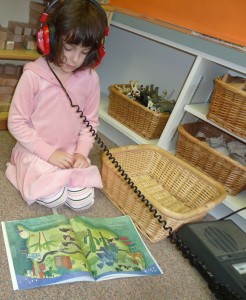 New Décor
New Décor
During our spider investigation, we learned that spiders have two body parts, an abdomen and a head. We inspected many plastic, paper, and even a few live examples of spider specimens to check our estimates regarding the number of legs they might have. (All of the children can now proudly state that there are eight!). We used this knowledge to create our own classroom arachnids.
Now that we have a room full of spiders, we need someplace for them to live. When the question was put to the children, they suggested that we needed a forest. Of course our concurrent discussion of bats inspired others to create a comfy cave and fancy, pink bat-house, as well. As you can see from the picture to the right, one student noticed that we were missing the sky and a sun. He quickly remedied this dire situation.
 Hungry Bats
Hungry Bats
In a separate activity, the students were asked to use one to one correspondence and number recognition to create lunch for some hungry fruit bats. They used orange play dough to roll “fruit” for each tree. We were practicing accurate counting from 1-10. At this stage, we expect them to begin to develop and consistently use reliable counting strategies. For example,they might touch each object as they count or move one object at a time to match each number they say.
One of the most difficult parts of this task in Pre-K is the tendency to forget that counting is needed. Generally, the children start counting as they create balls of dough, but get either overwhelmed or over enthusiastic as they progress past five. One of the skills we work on is to “go back and check” as they count. We frequently ask, “How many do you have now?” and “What number were you trying to make?”
Introducing: Automated Storytelling!
This past week, we also introduced the use of the “Listening Center”. Most of you are familiar with this school staple. Our first book was Bats Around the Clock, by Kathi Appelt. We practiced the ancient tradition of turning a tape recorder on and off (something that I’m sure they’ll never need to do outside of an early childhood classroom). After listening to the story, the students wrote about something that happened in the book. Throughout the year, a few of these “book reports” will make their way into the children’s portfolios for your enjoyment.

